![]()
![]()
![]()
Use LEFT and RIGHT arrow keys to navigate between flashcards;
Use UP and DOWN arrow keys to flip the card;
H to show hint;
A reads text to speech;
59 Cards in this Set
- Front
- Back
|
What breeds are affected by dilated cardiomyopathy?
|
Older large males, giant breeds: St. Bernard, Doberman, newfoundland
|
|
|
Define cardiac afterload
|
blood left in heart after it relaxes
|
|
|
What are the symptoms of dilated cardiomyopahty?
|
weakness, exercise intolerance (cough, lack of stamina), fainting, shock, heart murmur
|
|
|
What signs of dilated cardiomyopathy might you see as a massage therapist?
|
dog might not want to lie on side (they feel better standing), might wing his elbows out
|
|
|
Why does dilated cardiomyopathy cause coughing?
|
the heart pushes on the trachea
|
|
|
Decreased systolic function of the ventricles causes what effects, and what disease is this seen in?
|
decreased caridac output
increased cardiac afterload dilated cardiomyopathy |
|
|
What is the pathology of dilated cardiomyopathy?
|
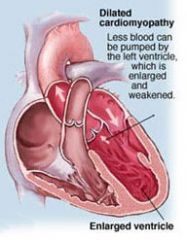
dilation of all heart chambers resulting in thin, weak, flabby heart muscle
|
|
|
What is the most common cause of mitral valve insuffiency?
|
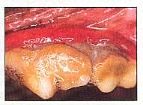
chronic dental disease
|
|
|
What is the pathology behind mitral valve insufficiency?
|
thickening of valve edges which then fail to close sufficiently during systole, resulting in the regurgitation of blood back into left atrium
|
|
|
What are the effects of mitral valve insufficiency on the heart and lungs?
|
left atrium dilates and causes pulmonary congestion and compression of bronchi
|
|
|
What are the symptoms of mitral valve insufficiency?
|
coughing, cough w/ exercise, decreased appetite, possibly swelling of limbs
|
|
|
Chances of acquiring mitral valve insufficiency increase with _____.
|
chances of acquiring increase with age
|
|
|
What are the affects of small intestine diarrhea?
|
impairment of absorptive surfaces, leading to more diarrhea, weight loss, dehydration
|
|
|
How are diarrheas of the small intestine classified?
|
by causative agent
|
|
|
Name 5 causative agents of small intestinal diarrhea.
|
1) parasitic- worms, protozoa
2) viral- parvo, distemper 3) bacterial- salmonella, clostridium 4) dietary intolerance/ sensitivity (allergy) 5) dietary indiscretion |
|
|
How is hypothyroidism primarily acquired?
|
acquired by atrophy or inflammation
|
|
|
What types of dogs are typically prone to hypothyroidism?
|
middle aged females, goldens, dobermen, cockers, shelties
|
|
|
What is the treatment for hypothyroidism?
|
thyroid supplementation (lifelong)
|
|
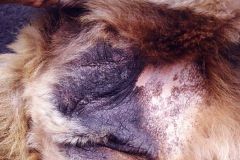
This may indicate:
|
hyperpigmentation due to hypothyroidism
|
|
|
What are the signs of hypothyroidism?
|
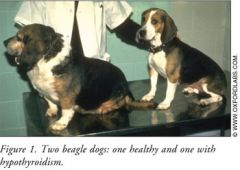
weight gain, dry, greasy skin, lethargy, hyperpigmentation, heat seeking, facial fold edema, bilateral symmetrical, alopecia, smells "wrong" (sour milk)
|
|
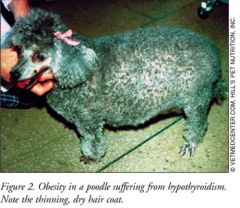
This dog may have:
|
Hypothyroidism. notice the dry, thin coat and weight gain
|
|

What does this dog have? Describe cause and symptoms
|
Ear mites, which lie on skin surface of external ear. Very itchy, highly contagious, "coffee ground" discharge, 3-4 week life cycle
|
|
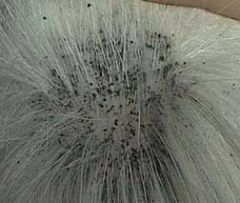
If you see this, expect _____. What does this material represent?
|
Fleas. The black is flea dirt, usually near tail head. Very itchy
|
|
|
Describe the possibe results of a tick bite.
|
filters red blood cells from 5 ml of blood,
disease vector for bacterial, viral, rickettsial and protozoan diseases local irritation paralysis caused by neurotoxins |
|
|
Name the two types of mange, typical age groups, site of infestation and level of contagion
|
demodetic- mostly young dogs, not contagious, lives in hair follicles
sarcoptic- any age, very contagious, burrows into skin and lays eggs |
|
|
Name some symptoms of sarcoptic mange, and why is it itchier than demodex?
|

can't sit still, red crusty lesions
|
|
|
How are both types of mange diagnosed?
|
diagnosed by skin scrapings
|
|
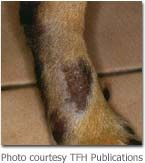
What condition could this be? What is happening to the skin
|
ringworm, hypertrophy of the skin caused by enzymes
|
|
|
Where is ringworm found?
|
soil organism, contagious, carriers may not show symptoms, fungal elements remain infectious for 18-24 months
|
|
|
What are the signs of ringworm?
|
grey, scaly areas, mostly on the face and feet
|
|
|
Anemia is usually ________ to a primary disorder. Name three general reasons for anemia.
|
secondary
extravascular blood loss, intravascular blood loss, lack of production of red blood cells |
|
|
Name some reasons for extravascular blood loss.
|
external- wound, trauma
internal- ulcers, bleeding tumor |
|
|
Name some reasons for intravascular blood loss.
|
parasites- ehrlicia, hemobartonella (cats)
autoimmune disease- IMHA (hemolytic anemia) -toxins |
|
|
What is the underlying mechanism for intravascular blood loss?
|
red cell destruction
|
|
|
Name three reasons for lowered production of red blood cells.
|
1) bone marrow suppression/ cancer
2) drugs- estrogen, chemo 3) kidney disease- erythropoietin |
|
|
What is the most common hematopoietic tumor in dogs?
|
lymphoma
|
|
|
>85% of lymphoma cases involve:
|
regional or generalized enlargment of lymph nodes (usually bilateral)
|
|
|
What is the life expectancy of dogs with lymphoma? With treatment?
|
4-6 weeks, >6 months with treatment (remission rates close to 90%
|
|
|
What is the most common injury to the stifle and a major cause of degenerative joint disease?
|
cranial/anterior cruciate ligament rupture
|
|
|
How long does it take degnerative joint disease to show signs after a ACL?
|
signs show as early as two weeks post injury
|
|
|
Describe the two forms of cranial cruciate ligament injury and give symptoms.
|

partial rupture- minor instability
complete rupture- decrease range of motion, drawer sign, can't do flexion or extension, muscle atrophy |
|
|
Half of dogs with C/ACL injury rupture the oppostie leg within ___months.
|
six months
|
|
|
What are the two types of surgeries for CCL rupture?
|
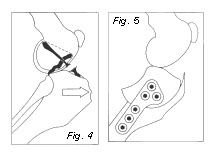
extracapsular- clean out debris, stabilize with fishing line
TPLO- tibial plateu leveling osteotomy |
|
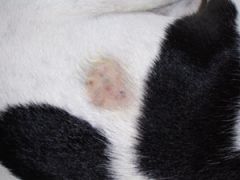
What is a common cause of such a lesion?
|
mange, demodetic
|
|
|
Name four things that predispose a dog to hip dysplasia?
|
1) genetics
2) enviroment and diet 3) disparity between muscle mass and developing skeleton (pull skeleton "out of whack" 4) failure of soft tissue of hip to maintain joint congruity resultin in bony changes |
|
|
What are the signs of hip dysplasia?
|
difficulty rising, stiffness that decreases with warm-up, pain over hip joint, lameness, waddling, muscle atrophy, bunny hopping, feet together
|
|
|
Hip dysplasia is diagnosed by
|
diagnoed by radiograph, OFA or PENN
|
|
|
What are possible treatments for hip dysplasia?
|
moderate excercise, weight control, NSAIDs, nutriceuticals, surgery
|
|
|
describe the possible surgeries for hip dysplasia and the indications for each.
|
1) remove head of femur, false joint forms of scar and muscle tissue <50 lbs
2) total hip replacement >50 lbs |
|
|
what is the underlying pathology of intervertebral disk disease?
|
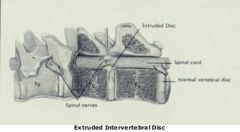
rupture of annulus fibrosis and extension of disk into spinal cord
|
|
|
Name typical areas of the spine prone to intervertebral disk disease.
|
lumbar (Wobblers)
caudal thoracic cervical |
|
|
Describe the two types of intervertebral disk disease.
|
Type 1- acute rupture, no pain, paralysis. Treatment- surgery
Type 2- chronic, less sever signs related to location of lesion. Pain and mild neurological deficits. steroids |
|
|
What is the treatment for degenerative myelopathy?
|
rehab
|
|
|
What is the underlying cause of degenerative myelopathy?
|
autoimmune response to nervous system, diffuse degneration of white matter (myelin), esp in thoracic region- genetic
|
|
|
What breeds tend to be afflicted with degenerative myelopathy?
|
German shephard, collie, husky, lab
|
|
|
What are the signs of degenerative myelopathy?
|
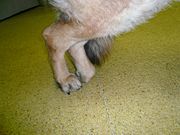
progressive ataxia and paresis of rear legs, muscle wasting from disuse or neurogenic atrophy, no pain
|
|
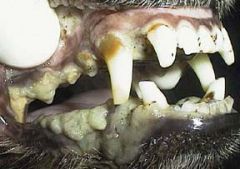
The image to the left indicates:
|
anemia
|
|
|
What are the signs of lymphoma?
|
enlarged lymph node
weight loss anorexia lethargy |
|
|
What breeds are prone to lymphoma?
|
boxer, bull mastiff, bassett hound, goldens
|

